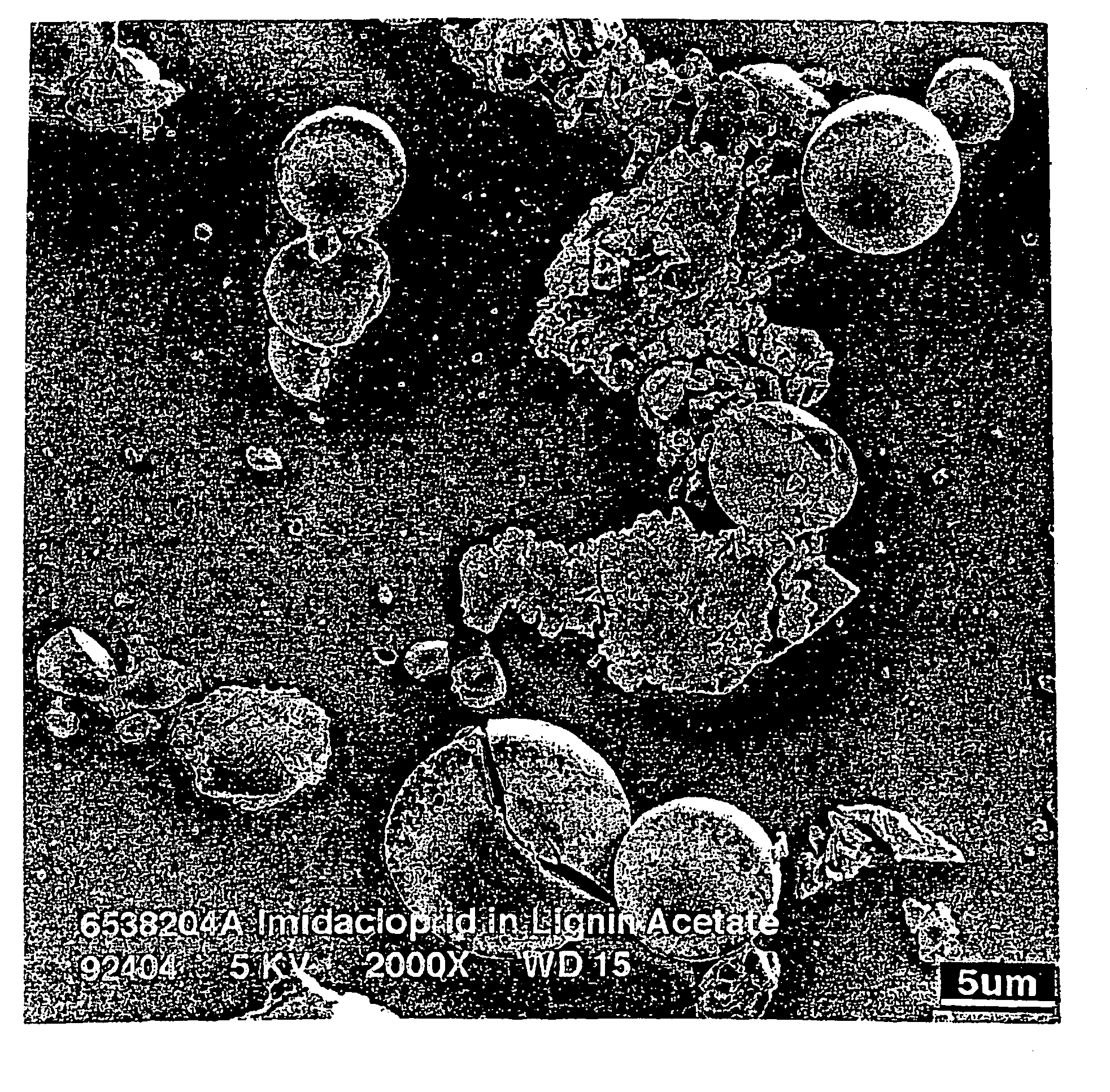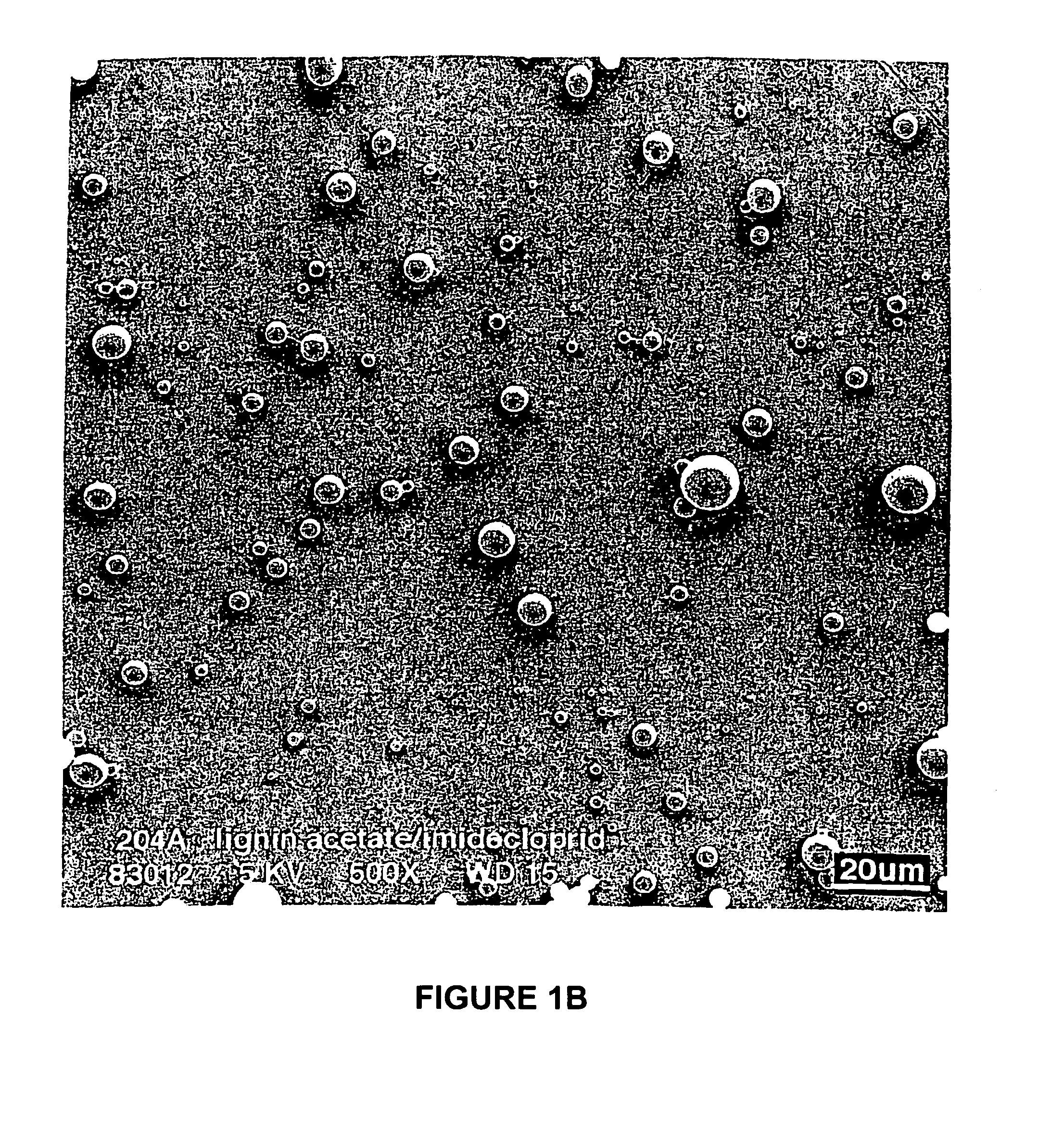Lignin-based microparticles for the controlled release of agricultural actives
a technology of agricultural actives and microparticles, which is applied in the direction of heterocyclic compound active ingredients, biocides, biocides, etc., can solve the problems of unanticipated contact with such compounds over a long time or at high concentrations, and many of these materials are toxic to humans and other animals, and achieve low environmental impact.
- Summary
- Abstract
- Description
- Claims
- Application Information
AI Technical Summary
Benefits of technology
Problems solved by technology
Method used
Image
Examples
example 1
[0095]This example shows the production of lignin-based matrix microparticles for the controlled release of imidacloprid.
[0096]An aqueous solution of methyl cellulose (1.09 g; Methocel A15LV, available from Dow Chemical Co.) was prepared in a 400 ml beaker by mixing with 89.71 g of water, and the solution was cooled to 4° C. in an ice bath. An organic solution containing imidacloprid (1.7 g; available commercially in formulations under the trade names Admire®, Gaucho®, Confidor® and Winner®, all from Bayer AG), and lignin acetate (14.8 g; available from Aldrich) was prepared by mixing with methylenechloride (93.5 g, available from Aldrich) until all solids had gone into solution. The organic solution was then added to the aqueous solution in the beaker over a period of about 30 seconds, during which time the mixture in the beaker was agitated with a high shear mixer (Silverson, Model L4R) equipped with a 6-hole screen. The mixture was agitated with the high shear mixer for a total o...
example 2
[0103]This illustrates the formation of lignin-based matrix microparticles having a higher imidacloprid loading than in Example 1.
[0104]Lignin-based matrix microparticles for the controlled release of imidacloprid were produced as described in Example 1, except that 10.9 g of lignin acetate was used, instead of 14.8 g, and 97.4 g of methylenechloride was used, rather than 93.5 g. After the removal of methylenechloride, 64.25 g of a white slurry of microparticles was collected. The average particle size was 6.5 microns, and the REA was 11.4%. No crystals of imidacloprid were apparent in an electron micrograph of the slurry. The slurry was tested for release rate as described in Example 1, and the release rate curve shown in FIG. 4 indicated a t1 / 2 of about 2000 hours.
example 3
[0105]This illustrates the formation of lignin-based matrix microparticles having smaller size.
[0106]Lignin-based matrix microparticles for the controlled release of imidacloprid were produced as described in Example 1, except that the setting of the Silverson high shear device was operated at a setting of 5.5, rather than 3. The average particle size was reduced to 5.6 microns, and the REA was 7.2%. No crystals of imidacloprid were apparent in an electron micrograph of the slurry. The slurry was tested for release rate as described in Example 1, and the release rate curve shown in FIG. 5 indicated a t1 / 2 of about 2000 hours.
PUM
| Property | Measurement | Unit |
|---|---|---|
| diameter | aaaaa | aaaaa |
| diameter | aaaaa | aaaaa |
| diameter | aaaaa | aaaaa |
Abstract
Description
Claims
Application Information
 Login to View More
Login to View More - R&D
- Intellectual Property
- Life Sciences
- Materials
- Tech Scout
- Unparalleled Data Quality
- Higher Quality Content
- 60% Fewer Hallucinations
Browse by: Latest US Patents, China's latest patents, Technical Efficacy Thesaurus, Application Domain, Technology Topic, Popular Technical Reports.
© 2025 PatSnap. All rights reserved.Legal|Privacy policy|Modern Slavery Act Transparency Statement|Sitemap|About US| Contact US: help@patsnap.com



